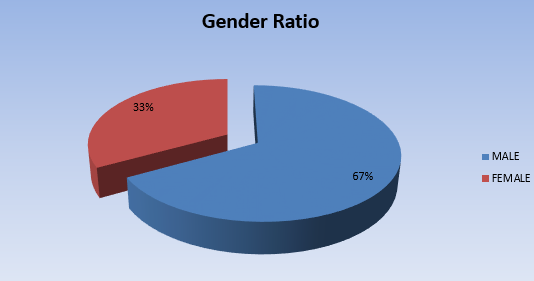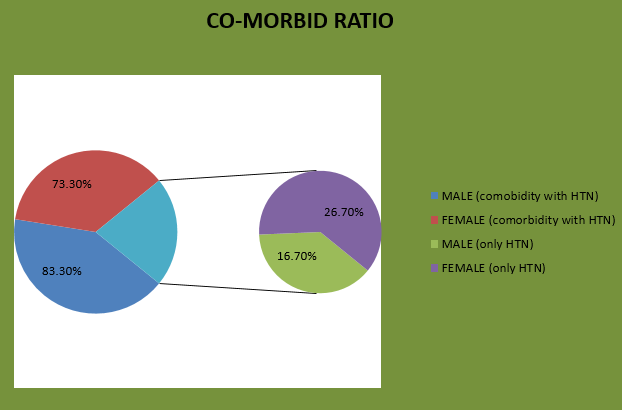- Visibility 206 Views
- Downloads 53 Downloads
- Permissions
- DOI 10.18231/j.ijpp.2021.040
-
CrossMark
- Citation
Prevalence of hypertension associated with existing comorbid heath issues — An observational survey report
- Author Details:
-
Deepak Kumar Dash
-
Anil Kumar Sahu
-
Vaibhav Tripathi *
-
Ajeet Kumar Sonkar
-
Pankaj Sonkar
-
Sunil Sonkar
Abstract
Hypertension has arisen as a significant general medical issue around the world. Hypertension is the main danger factor for chronic disease trouble in India. Survey studies from different parts of India have announced a high predominance of hypertension. Former studies have suggested that metropolitan- rural intermingling of hypertension in India is because of the quick urbanization of country populaces with ensuing changes in lifestyles (inactivity, high dietary salt, sugar, and excess fat in diet regimen) and an expansion in overweight and stoutness.
Here, we documented a survey report on the prevalence of hypertension. We used gender and pre-existing body ailment as an indicator for this observational study. The study was carried out for 1 month (1st to 31st of January 2021) with a sample size of n= 450. Data were collected by reviewing the patient’s medical records. Depending on gender and co-morbidity, patients were categorized into two groups. We found a greater prevalence of hypertension in men (67%) than women (33%). We recorded an increasing trend in the prevalence of hypertension associated with preexisting disease in males (83%) and females (73%).
Good quality long-term studies will help to understand hypertension in all aspects; furthermore, it would help in its avoidance, screening, and control. Lastly, we would state that effective prevention and management programs should be broadly executed in India, particularly in developing urban cities.
Introduction
Hypertension is otherwise called high arterial blood pressure (BP), which is a chronic ailment where the pressure of blood in the systemic aorta is determinedly raised. Arterial hypertension is a significant reason for grimness and mortality due to its relationship with coronary heart disease, renal disease, and cerebrovascular disease. The degree of target organ association (for example heart, mind, and kidneys) decides the physiological consequences. Whenever left uncontrolled, complications from raised blood pressure incorporate cardiovascular breakdown, fringe vascular disease, renal insufficiency, retinal discharge, visual hindrance, stroke, and dementia.[1], [2]
As per most significant guidelines, it is suggested that hypertension should be analyzed when an individual's systolic blood pressure (SBP) in the office or clinic is ≥140 mm Hg or potentially their diastolic blood pressure (DBP) is ≥90 mm Hg following rehashed assessment.[Table 1] gives a classification of blood pressure based on clinic BP assessment.[3]
|
Category |
Systolic (mm Hg) |
Optional |
Diastolic (mm Hg) |
|
Normal BP |
<130 |
And |
<85 |
|
High-normal BP |
130–139 |
and/or |
85–89 |
|
Grade 1 hypertension |
140–159 |
and/or |
90–99 |
|
Grade 2 hypertension |
≥160 |
and/or |
≥100 |
Affirmation of hypertension can be proven by estimating the BP based on standard convention.
|
Category |
SBP/DBP, mm Hg |
|
OBPM |
≥140 and/or ≥90 |
|
ABPM |
|
|
24-h average |
≥130 and/or ≥80 |
|
Day time (or awake) average |
≥135 and/or ≥85 |
|
Night time (or asleep) average |
≥120 and/or ≥70 |
|
HBPM |
≥135 and/or ≥85 |
[Table 2]: Criteria for hypertension based on office (OBPM), ambulatory (ABPM), and home blood Pressure measurement (HBPM).[4]
Standard Procedure for Blood Pressure Measurement
The estimation of BP in the office or center is most usually the reason for hypertension diagnosis and follow-up. Office BP ought to be estimated by suggestions displayed in [Table 3]
|
Category |
Protocol |
Inference |
|
OBPM |
At each visit take 3 readings with 1 min intervals each reading. Estimate the average of the last 2 estimations. If BP of the first reading is <130/85 mm Hg no further estimation is required. |
Blood pressure of 2–3 office visits ≥140/90 mm Hg indicates hypertension. |
|
HBPM |
Before each visit to the health professional: • 3–7-day observing in the morning (prior day drug consumption if treated) and the evening. • Two estimations on each event after 5 min sitting rest and 1 min between estimations. Long haul follow-up of treated hypertension: • 1–2 estimations each week or month. |
•Average HBPM after barring readings of the first day ≥135 or 85mm Hg demonstrates hypertension. |
|
ABPM |
• 24-hour checking at 15–30 min spans during daytime and evening. • At least 20 valid daytime and 7 evenings BP readings are required. If less, the test ought to be rehashed. |
• 24-hour ABPM ≥130/80 mm Hg shows hypertension (essential criterion). • Day time (alert condition) ABPM ≥135/85 mm Hg and evening time (sleeping) ≥120/70 mm Hg shows hypertension. |
Hypertension epidemiology in India
Non-communicable infections (NCDs) are by a wide margin the main source of death around the world. In 2016, they were answerable for 71% (41 million) of the 57 million deaths which happened universally. The major NCDs liable for these deaths are cardiovascular diseases (17.9 million deaths, representing 44% of all NCD deaths and 31% of all worldwide deaths). As indicated by the WHO survey report 2018, the level of cardiovascular death rate is 27 % in India.[7], [8]
Rajeev Gupta et al. examined the hypertension pervasiveness information, acquired from the National Family Health Survey Program 2018. The information shows that there are critical contrasts in the pervasiveness of hypertension in various states of the country. Hypertension prevalence is a lot more prominent in southern, northeastern, and north-western states of the nation and is altogether more noteworthy in men when compared with women.[9], [10]
Survey description
It was an observational study. This study aimed to figure out the prevalence of hypertension among peoples in the Raipur district of Chhattisgarh state. Gender and comorbid pathological status were taken as an indicator for the survey. The site of the survey was a mobile medical bus unit and it was conducted in January 2021 for 30 days.
In this study, out of 450 individuals, there were 150 women and 300 men. A patient demographical representation is given in [Table 4] along with [Figure 1].
Statistics
|
Gender |
No. of Patients |
Co-Morbid patients |
Sample size |
|
Male |
300 |
250 |
450 |
|
Female |
150 |
110 |

We found that 250 men out of 300 were already suffering from one or more chronic diseases. In addition, 110 women out of 150 were found affected with other bodily ailments as shown in [Figure 2].

Our second indicator was the comorbid status of individuals. So, we have also figure out the gender-wise number of patients based on existing complications ([Table 5] & [Figure 2]).
|
S. No. |
Existing pathological problem |
Male Patients |
Female Patients |
|
1 |
Hyperacidity |
70 |
40 |
|
2 |
Intermittent pyrexia |
50 |
20 |
|
3 |
Hyperglycemia |
40 |
20 |
|
4 |
Hypothyroidism |
10 |
25 |
|
5 |
Chronic cough |
80 |
5 |
|
250 |
110 |

Treatment Protocol
Patients were advised to take amlodipine, atenolol, and telmisartan for the management of hypertension. Combinations of these drugs were prescribed on the basis patient’s pathological condition and severity of hypertension disorder.
Advice given to the patient
Regular exercise, a healthy diet regimen, which should include potassium-rich vegetables and least consumption of sodium, quit smoking and hard drinks, and blood pressure monitoring at home had been advised by the doctor.
Discussion
Blood pressure was measured by following the standard protocol of “official blood pressure measurement” (OBPM). According to the protocol, the indication number for hypertension is considered as ≥140 and/or ≥90 systolic and diastolic respectively.
It was found that 83% of male individuals were already suffering from a chronic ailment as shown in table 5. It indicates that hypertension may be a secondary disorder due to the existing problem. Furthermore, chronic coughing and hyperacidity were observed as a common existing problem in males; which also indicates chain-smoking habit and irregularity in routine respectively.
On the other hand, 73% of female population was diagnosed to have other diseases ([Table 5]). We observed that most of the females were suffering from hyperacidity and hypothyroidism before hypertension disorder, which again indicates that daily routine is not systematic along with malnutrition.
Limitations of the present study
The diagnosis is solely made on patient history and clinical findings. The assessment was not done as the patient was feeling reluctant and no objective parameters were used in the present study.
We had observed some other chronic ailments in hypertensive patients, but we only took five common diseases/disorders for the survey data. As we all know the current pandemic situation. It is due to this reason the survey was done by following the COVID guidelines.
Thus, present study findings cannot be generalized and further experimental and/or clinical studies with a large sample are required to substantiate the present study observations.
Conclusion
Hypertension is mainly considered as a daily routine disorder; it means that only drug is not enough to combat this problem but doctor’s advice regarding diet regimen, regular exercise, home blood pressure monitoring, and stress management would also play a significant role in the management of hypertension.
Source of Funding
None.
Conflict of interest
None.
References
- Beevers G, GYL, O'Brien E. The pathophysiology of hypertension. BMJ. 2001;322(7291):912-8. [Google Scholar] [Crossref]
- Hall JE, Granger JP, Carmo JMD, Silva AAD, Dubinion J, George E. Hypertension: physiology and pathophysiology. Compr Physiol . 2012;2(4):2393-442. [Google Scholar] [Crossref]
- Böhm M, Schumacher H, Teo KK, Lonn E, Mahfoud F, Mann JF. Achieved diastolic blood pressure and pulse pressure at target systolic blood pressure (120-140 mmHg) and cardiovascular outcomes in high-risk patients: results from ONTARGET and TRANSCEND trials. Eur heart J. 2018;39(33):3105-14. [Google Scholar] [Crossref]
- O’brien E, Dolan E. Ambulatory blood pressure monitoring for the effective management of antihypertensive drug treatment. Clin ther. 2016;38(10):2142-51. [Google Scholar] [Crossref]
- Unger T, Borghi C, Charchar F, Khan NA, Poulter NR, Prabhakaran D. International Society of Hypertension global hypertension practice guidelines. Hypertension. 2020;75(6):1334-57. [Google Scholar] [Crossref]
- Todkar S, Padwal R, Michaud A, Cloutier L. Knowledge, perception and practice of health professionals regarding blood pressure measurement methods: a scoping review. J Hypertens. 2021;39(3):391-9. [Google Scholar] [Crossref]
- Ganju A, Goulart AC, Ray A, Majumdar A, Jeffers BW, Llamosa G. Systemic solutions for addressing non-communicable diseases in low-and middle-income countries. J multidiscip Healthc. 2020;13:693-707. [Google Scholar] [Crossref]
- Akselrod S. World Health Organization. Noncommunicable diseases country profiles. . 2018. [Google Scholar]
- Gupta R. Convergence in urban-rural prevalence of hypertension in India. J Hum Hypertens . 2016;30(2):79-82. [Google Scholar] [Crossref]
- Gupta R, Gaur K, Ram CV. Trends in hypertension epidemiology in India. J Hum Hypertens. 2019;18(2):73-8. [Google Scholar] [Crossref]
How to Cite This Article
Vancouver
Dash DK, Sahu AK, Tripathi V, Sonkar AK, Sonkar P, Sonkar S. Prevalence of hypertension associated with existing comorbid heath issues — An observational survey report [Internet]. Indian J Pharm Pharmacol. 2021 [cited 2025 Nov 04];8(3):231-234. Available from: https://doi.org/10.18231/j.ijpp.2021.040
APA
Dash, D. K., Sahu, A. K., Tripathi, V., Sonkar, A. K., Sonkar, P., Sonkar, S. (2021). Prevalence of hypertension associated with existing comorbid heath issues — An observational survey report. Indian J Pharm Pharmacol, 8(3), 231-234. https://doi.org/10.18231/j.ijpp.2021.040
MLA
Dash, Deepak Kumar, Sahu, Anil Kumar, Tripathi, Vaibhav, Sonkar, Ajeet Kumar, Sonkar, Pankaj, Sonkar, Sunil. "Prevalence of hypertension associated with existing comorbid heath issues — An observational survey report." Indian J Pharm Pharmacol, vol. 8, no. 3, 2021, pp. 231-234. https://doi.org/10.18231/j.ijpp.2021.040
Chicago
Dash, D. K., Sahu, A. K., Tripathi, V., Sonkar, A. K., Sonkar, P., Sonkar, S.. "Prevalence of hypertension associated with existing comorbid heath issues — An observational survey report." Indian J Pharm Pharmacol 8, no. 3 (2021): 231-234. https://doi.org/10.18231/j.ijpp.2021.040
